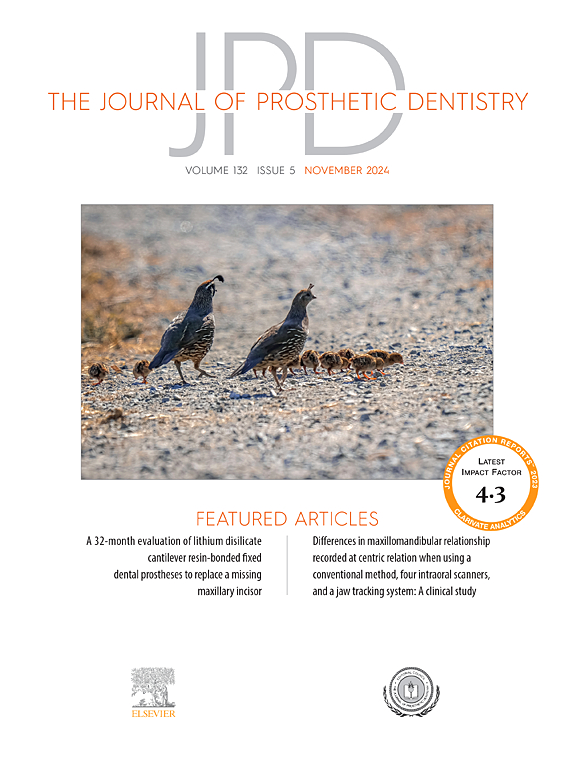Comparative analyses of time efficiency and cost in fabricating fixed implant-supported prostheses in digital, hybrid, and conventional workflows: A systematic review and meta-analysis
IF 4.3
2区 医学
Q1 DENTISTRY, ORAL SURGERY & MEDICINE
引用次数: 0
Abstract
Statement of problem
Economic considerations affect whether new technologies are adopted in dental practice. Limited evidence exists regarding the time and cost efficiency of different workflows for fabricating implant-supported restorations.
Purpose
The purpose of this systematic review and meta-analysis was to compare the time and cost involved in fabricating fixed implant-supported prostheses using digital, hybrid, and conventional methods throughout the entire prosthetic treatment by analyzing both clinical and laboratory steps.
Material and methods
A systematic review was conducted following the Preferred Reporting Items for Systematic reviews and Meta-Analyses (PRISMA)-P 2015 guidelines. The methods and inclusion criteria were specified in a protocol registered with the International Prospective Register of Systematic Reviews (PROSPERO) (registration number CRD42023458734). The databases PubMed, Cochrane, and PROSPERO were searched using keywords: (Prosthodontic OR restorative dentistry OR denture) AND (CAD CAM OR Digital workflow OR Computer Dentistry OR Digital Design) AND (Economic OR cost OR Financial OR time efficiency). Two investigators selected articles independently.
Results
A qualitative synthesis of 12 articles published from 2010 to 2023 showed that digital scans took less time than conventional impressions (P<.05) in 7 out of 9 articles. Additionally, 8 articles revealed significant reductions in laboratory working time with digital workflows, intermediate times with hybrid workflows, and longer times with conventional workflows (P<.001). Meta-analysis confirmed the time efficiency of digital scanning over conventional impressions (Hedges g=1.65, 95% CI [0.33, 2.98]) and a substantial reduction in laboratory time with digital workflows compared with other workflows (Hedges g=6.55, 95% CI [2.69; 10.42]). However, no significant difference was found in adjustment time between digital and other workflows (Hedges g=0.91, 95% CI [−0.72; 2.55]). Direct laboratory costs were observed to be higher in conventional workflows compared with hybrid or digital workflows, with hybrid workflows also showing elevated costs compared with digital workflows (P<.05).
Conclusions
The digital workflow demonstrates potential benefits in reducing scan time, laboratory processing time, and direct laboratory costs for implant-supported restorations in partial edentulism. Further research is needed to validate these findings, particularly for long-span implant-supported fixed partial prostheses.
在数字化、混合和传统工作流程中制作固定种植体支持修复体的时间效率和成本比较分析:系统回顾和荟萃分析。
问题陈述:经济因素会影响牙科实践中是否采用新技术。目的:本系统综述和荟萃分析旨在通过分析临床和实验室步骤,比较在整个修复治疗过程中使用数字、混合和传统方法制作固定种植体修复体所需的时间和成本:根据《系统综述和荟萃分析首选报告项目》(Preferred Reporting Items for Systematic Review and Meta-Analyses,PRISMA)-P 2015指南进行了系统综述。方法和纳入标准已在国际系统综述前瞻性注册中心(PROSPERO)(注册号:CRD42023458734)注册。在 PubMed、Cochrane 和 PROSPERO 数据库中搜索关键词:(义齿修复或修复牙科或义齿)和(CAD CAM 或数字化工作流程或计算机牙科或数字化设计)和(经济或成本或财务或时间效率)。两名研究人员独立选择文章:结果:对 2010 年至 2023 年发表的 12 篇文章进行的定性综述显示,数字扫描所需的时间少于传统印模(PConclusions:数字化工作流程在减少部分缺牙症种植体支持修复的扫描时间、技工室处理时间和技工室直接成本方面具有潜在优势。还需要进一步的研究来验证这些发现,特别是对于大跨度种植体支持的固定部分修复体。
本文章由计算机程序翻译,如有差异,请以英文原文为准。
求助全文
约1分钟内获得全文
求助全文
来源期刊

Journal of Prosthetic Dentistry
医学-牙科与口腔外科
CiteScore
7.00
自引率
13.00%
发文量
599
审稿时长
69 days
期刊介绍:
The Journal of Prosthetic Dentistry is the leading professional journal devoted exclusively to prosthetic and restorative dentistry. The Journal is the official publication for 24 leading U.S. international prosthodontic organizations. The monthly publication features timely, original peer-reviewed articles on the newest techniques, dental materials, and research findings. The Journal serves prosthodontists and dentists in advanced practice, and features color photos that illustrate many step-by-step procedures. The Journal of Prosthetic Dentistry is included in Index Medicus and CINAHL.
 求助内容:
求助内容: 应助结果提醒方式:
应助结果提醒方式:


